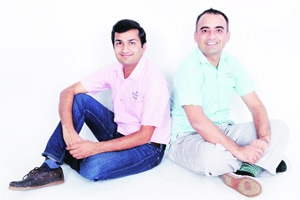ANY BEVERAGE can be made to taste good or nutritious. But how many can tell a story? Neeraj Kakkar’s Paper Boat does. Remember the times when you would be playing ‘gully cricket’ during your summer holidays and your mother would call you to hand over a glass of refreshing aam panna or jaljeera? Or the time you would simply laze in the afternoon and savour aamras in the courtyard? Or your sister making never-ending requests to the golgappe-walla to add some more paani after her fill was over? Paper Boat has tried to relive those memories, emulating those tastes and experiences that define traditional India, but at the same time standing tall on the benchmark of hygiene and safety.
And it’s doing that in good measure. Hector Beverages, founded by Kakkar, a former Hindustan Coca-Cola Beverages employee, along with two others in 2011, sells close to 1.5 million packs of Paper Boat a month (based on some reports; the company doesn’t want to disclose any figures, sales or otherwise). That’s a huge number for a company that started the product only over a year ago and competes with the likes of Coca-Cola and Pepsi. Hector Beverages entered the R1,800-crore beverage market in the country with Tzinga, which became an instant hit in the energy drinks market. Paper Boat, its second foray, was born as a result of the passion the team felt for fast-disappearing traditional Indian drinks.
“We have a treasure trove of ethnic drinks in India. They are immensely popular locally but unheard of in the rest of the country. We wanted to turn these local hits into national sensations. These drinks have been moulded both by history and geography. They have been perfected over centuries. They have been traditionally had in pockets across the country. Our products cater to those who grew up with those drinks,” says Kakkar, who holds a double MBA from MDI Gurgaon and Wharton School of Business, respectively. He worked with Coca-Cola for eight years before starting Hector Beverages.
Kakkar recalls an incident when he was travelling by air and he met a native of Bihar. That was just after launching Paper Boat’s new sattu drink variant. “He was a lawyer by profession and happened to have our drink on that flight. After landing, he noticed me wearing a shirt with Paper Boat written on it. He told me that he has been drinking sattu (a traditional Bhojpuri drink consisting of a mixture of ground pulses and cereals) for as long as he can remember and that he loved our drink. He also pointed out that the copy on the back mentioned Darghanga, his hometown, and that it brought tears to his eyes. When we started out, we had no idea that we were going to make such a difference. It’s pretty overwhelming,” he adds.
So far, Paper Boat’s roster consists of aamras, aampanna, jaljeera, kokum, jamun kala khatta, imli ka amlana and golgappe ka pani. Sattu and rasam are the latest to be added to the list. Sometime ago, Hector Beverages also launched tulsi and ginger lemon ice tea. Paper Boat tries to make its products as natural as possible. Most of the ingredients are natural. “But our greatest deterrent here is the great Indian heat. As is the risk of the fruit juice changing the chemical composition. Nature-identical flavouring makes it more resilient to chemical changes,” says Kakkar.
There are some ingredients that are common to all, like acidity regulators (vitamin C, found naturally in all citrus plants) and stabilisers (pectin, a binding agent found exclusively in plant cells), which again are natural when it comes to Paper Boat, adds Kakkar.
But how do they ensure longevity on the shelves? “Food processing technologies related with high pressure, aseptic and heat have been available across the world for good shelf lives without adding preservatives. We have adapted those technologies to Indian conditions,” explains Kakkar, adding: “Paper Boat pouches are made of a four-part laminate. The two outer layers are a blend of proprietary polypropylene and polyethylene. This makes the pack withstand extremes in pressure and heat while at the same time being easy to print upon. This is the one time you can actually judge something by its cover.
Right now, Paper Boat intends to target mostly metropolitan cities and other up-and-coming cultural melting pots. “We would place the average Paper Boat drinker’s age bracket somewhere between 25 and 40 years. As for locations, thanks to our e-commerce portal, http://www.shoppaperboat.com, we are now available in 65 cities and towns across the nation. We also have a burgeoning diaspora to cater to and, right now, we are available in around 10 countries, including the UK, the US, the UAE, Canada, Australia and Malaysia,” adds Kakkar. Paper Boat sells the same quality of its products everywhere, irrespective of geographical boundaries.
Paper Boat has good distribution channels in Delhi and Bangalore. “Both these markets are performing exceptionally well. But whatever limited distribution we have in Chennai, Hyderabad, Mumbai and Pune, those are also very high on per outlet volume. So, we can safely say there is no north-south or east-west divide, which exists in terms of product acceptance,” offers Kakkar.
Paper Boat is manufactured in the company’s flagship plants at Manesar in Haryana and Mandideep in Madhya Pradesh. Its third plant in Mysore, Karnataka, will be operational by the middle of next year. The company has about 250 people on its payrolls.By the end of next year, Kakkar hopes to make around 25 new drinks, including nimbu pani, bel and his personal favourite, kanji, made from purple carrots. “So, 11 down, 14 more to go,” he adds.

